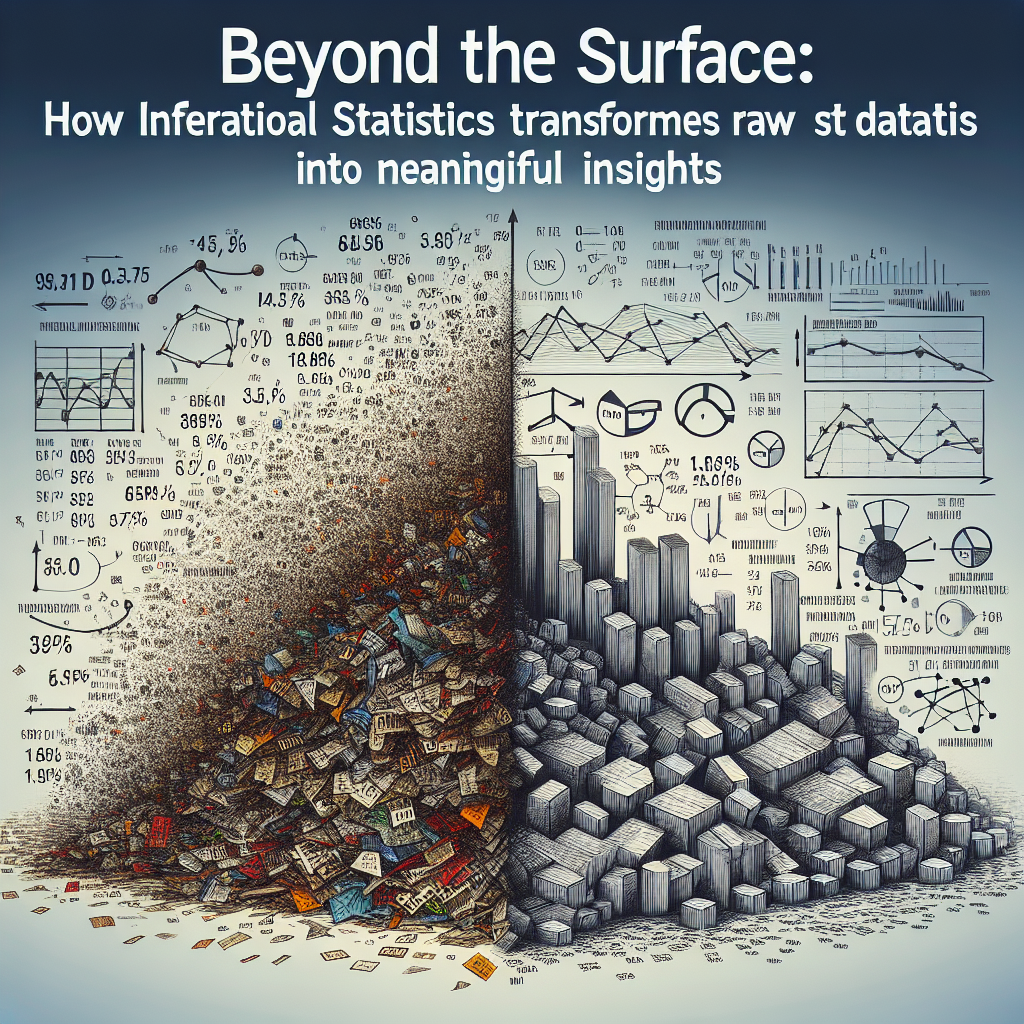Introduction
In today’s data-driven world, we are constantly surrounded by an avalanche of information. From social media interactions to market trends, raw data is generated at an astonishing rate. But how do we sift through this vast ocean of numbers to extract meaningful insights? The answer lies in inferential statistics. This powerful tool not only enhances our understanding of data but also allows us to make informed decisions based on statistical evidence. In this article, we’ll delve deep into the transformative power of inferential statistics and explore how it converts raw data into valuable insights—beyond the surface.
The Basics of Inferential Statistics
Before we dive into the intricacies of inferential statistics, it’s essential to understand its foundational concepts. Inferential statistics enables us to make predictions and generalizations about a population based on a sample. It allows researchers to draw conclusions from data using various statistical techniques, thus bridging the gap between mere raw data and actionable insights.
Key Concepts
-
Population vs. Sample: The population is the entire group you want to study, while a sample is a subset of that population. Inferential statistics relies on samples to infer characteristics about the full population.
-
Hypothesis Testing: This involves forming a hypothesis (a predictive statement) and determining its validity through statistical testing.
-
Confidence Intervals: These provide a range of values that likely capture the true population parameter, offering insights into the degree of uncertainty.
- P-Values: This critical value helps you determine the significance of your results, leading to more informed conclusions.
Why Inferential Statistics Matter
The significance of inferential statistics cannot be overstated. It plays a pivotal role in various fields, including healthcare, business, social sciences, and more. By using inferential methods, organizations can uncover patterns, test theories, and create strategies that drive success.
Case Study: Healthcare
In the healthcare industry, inferential statistics is crucial for clinical trials. By analyzing small groups of patients, researchers can infer the effectiveness of a new drug of treatment in the entire population. For example, during a clinical trial for a new cancer therapy, researchers used inferential statistics to conclude that the new treatment significantly improved patient outcomes compared to standard treatments.
How Inferential Statistics Transforms Raw Data
Now that we understand the basics and the importance of inferential statistics, let’s examine how it transforms raw data into meaningful insights.
Data Collection
The first step in any statistical analysis is data collection. This can be through surveys, experiments, or observational studies. Regardless of the method used, the quality of the raw data significantly influences the insights generated.
Data Analysis Techniques
Several techniques enable statisticians to draw meaningful conclusions from raw data:
-
Regression Analysis: This technique helps determine relationships between variables. For example, businesses can utilize regression to understand how advertising spending impacts sales.
Advertising Spend Sales $1000 $10,000 $2000 $25,000 $3000 $35,000 -
ANOVA (Analysis of Variance): This allows comparison of means across multiple groups, proving valuable when assessing the impact of different factors on outcomes.
- Chi-Square Tests: These are used to examine the relationship between categorical variables.
The Significance of Context
To truly grasp the power of inferential statistics, context is critical. Statistics in isolation can be misleading. For instance, a local grocery store may find that a survey indicates 80% of its customers prefer Brand A over Brand B. However, without considering sampling methods and customer demographics, such a statistic can be deceptive.
The Role of Software in Data Analysis
Modern software tools have simplified the process of performing inferential statistics. Tools such as R, Python, and SPSS allow researchers to analyze data efficiently and accurately. These platforms also offer user-friendly interfaces that facilitate exploration and visualization of data, making it easier for non-experts to glean insights.
Real-World Applications of Inferential Statistics
Case Study: Marketing Strategy
A market research firm uses inferential statistics to analyze consumer behavior. After surveying a sample of 1,000 individuals about their product preferences, they employ regression analysis to identify which marketing channels yield the highest conversion rates. As a result, the firm can channel resources effectively, enhancing overall profitability.
Addressing Potential Limitations
Despite its power, inferential statistics has limitations. Understanding these can prevent poor interpretations:
-
Misuse of Data: Inferential statistics can easily lead to incorrect conclusions if the data is not analyzed properly.
-
Sample Size: A small sample size can lead to unreliable results, highlighting the importance of robust sampling techniques.
- Confounding Variables: Failing to account for other influential factors can skew results.
Conclusion
In summary, inferential statistics serves as a bridge between raw data and meaningful insights. As we navigate an increasingly complex world filled with information, harnessing the power of inferential statistics becomes essential for making informed decisions. By employing these techniques, individuals and organizations can dive deeper into their data and glean actionable insights—truly going beyond the surface.
FAQs
1. What is inferential statistics?
Inferential statistics involves techniques that allow us to draw conclusions about a population based on a sample of data.
2. Why is inferential statistics important?
It enables organizations to make data-driven decisions, understand trends, and predict future outcomes effectively.
3. What are common methods used in inferential statistics?
Common methods include hypothesis testing, regression analysis, and ANOVA.
4. How can I ensure my data analysis is accurate?
Ensure a sufficient sample size, use appropriate statistical tests, and account for potential confounding variables.
5. What tools can I use for inferential statistics?
Popular tools include R, Python, Excel, and SPSS, each offering various features for data analysis.
By embracing inferential statistics, you not only understand the trends and patterns within your raw data but also position yourself to make informed decisions that drive success. Remember, the key to unlocking insights lies in going beyond the surface.

